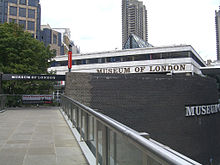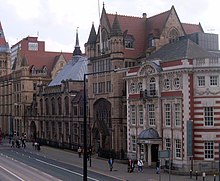Nick Merriman
Nick Merriman (born 6 June 1960)[1] is the director of the Horniman Museum in south London. Previously he was the director of the Manchester Museum in Manchester, England.
As of 1 June 2017, Merriman also acted as interim director of the Whitworth, University of Manchester. Previously Merriman worked at the Museum of London and University College, London. In April 2017 he was made honorary professor of museum studies in the University of Manchester. He is known for his contributions to the development of public archaeology and museum studies, and for influencing the heritage sector around issues of cultural diversity, sustainability and the future of collections. He is the chair of the Rothesay Pavilion Charity.
Early life
Merriman was born and brought up in Sutton Coldfield, and attended King Edward VI Grammar School in Edgbaston. From collecting old bottles stimulated by his father's collecting of antiques from the junk stores of Birmingham, he graduated to an interest in archaeology, excavating most weekends from the age of 16 at the local Roman site of Wall, Staffordshire. He studied Archaeology from 1979 to 1982 at the University of Cambridge, attending St John's College, and spent the summers excavating at the site of Gars-Thunau in Lower Austria.
From 1982 to 1983 he undertook a postgraduate course in Museum Studies at the University of Leicester, after which he returned to Cambridge to study for a PhD which examined social barriers to museum visiting. This was later published as 'Beyond The Glass Case: The Past, the Heritage and the Public' (1991).[2]
Education
- 1983–86 Department of Archaeology, University of Cambridge
- 1982–83 Department of Museum Studies, University of Leicester
- 1979–82 Department of Archaeology, University of Cambridge MA in Archaeology.[1]
Career
Museum of London

Merriman began his career at the Museum of London in 1986 as Curator of Prehistory and subsequently in 1991, Merriman became the head of Department of Early London History and Collections. During this time he led a project called ‘The Peopling of London’, which told the story of the capital's cultural diversity from ancient times to the present through a ground-breaking exhibition and related activities in 1993.[3] Merriman also authored and edited an accompanying book of the same title 1993.[4]
University College London
In 1997 Merriman joined the Institute of Archaeology at University College London as senior lecturer, where he ran the Museum Studies Masters course and developed new courses in cultural heritage studies and in public archaeology. He was later promoted to reader. While at UCL he became very interested in the university's extensive, but rather hidden, museums and collections, which include the Petrie Museum and the Grant Museum. He led the creation of a new university-wide museum service and became director of museums and collections alongside his academic duties.
Clore Leadership Programme
In 2004, Merriman joined the inaugural Clore Leadership Programme undertaking a bespoke scheme of training and development in cultural leadership. His research project looked at issues of memory and forgetting in memory institutions such as museums, in the context of thinking about sustainability and the disposal of objects from collections. Published in the journal Cultural Trends, this work was influential in driving the debate about these issues in the museum sector.[5] Merriman was successful in his application to join the scheme from over 400 other applicants.[6]
Manchester Museum

Merriman was appointed director of Manchester Museum in the University of Manchester in 2006. Since his appointment, Merriman has focused the museum's mission on promoting understanding between cultures and working towards a sustainable world and has also overseen the refurbishment of most of the museum's permanent galleries. This, together with a major programme of public engagement, has led to a doubling of the museum's visitor numbers to over 450,000 a year.[7]
The museum has gained a reputation for innovative work. This has included the installation of a 'hermit' in the museum's tower in 2009 where a performance artist, Ansuman Biswas, lived for 40 days and 40 nights, contemplating the future of the planet and inviting people to think about why museums hold on to huge amounts of material,[8] and the use of Villa Eugénie — who normally work in fashion launches — to work on the radical redisplay of the museum's natural history galleries.[9]
More recently, Merriman has been developing a new interdisciplinary approach to collecting in large disciplinary museums, based on themes such as 'water' and 'migration', and has been moving the museum to campaign more around issues such as climate change and extinction.[10]
In 2010, in response to public funding constraints, he worked with Maria Balshaw to combine the staff structures of the Manchester Museum and the Whitworth to form two independent museums with shared staff structures, in a pioneering approach to collaboration.[11]
In 2017 Merriman was made Honorary Professor of Museum Studies in the University of Manchester.
Capital Transformation
In 2015 Merriman began a major capital redevelopment of Manchester Museum entitled the Courtyard Project. The project will transform the museum with a major two-storey extension consisting of a permanent gallery on the history and culture of South Asia in partnership with the British Museum, a major space for temporary exhibitions, a new main entrance, and much-improved visitor facilities inspired by a new ethos of a ‘Museum for Life.’
Work will commence in May 2018, and the finished building will reopen in early 2020. HM Treasury announced a grant of £5million towards developing the new South Asia Gallery in November 2015, and development funding of £406,400 has been awarded by Heritage Lottery Fund to help Manchester Museum progress its plans to apply for a full grant of £4.2 million. The total cost of the Courtyard Project is expected to be £13.5 million.
Other roles
Away from Manchester Museum, Merriman has been invited to chair several other organisations. He was chair of the International Council of Museums (UK) from 2001 to 2004, president of the Council for British Archaeology from 2005 to 2008 and chair of the University Museums Group from 2009 to 2013.
Merriman was convenor of the Museums Association's ethics committee from 2008 to 2014 and chair of the Collections Trust [12] from 2013 to 2016.
In 2017 he was appointed chair of the Wellcome Trust’s Inspiring Science Fund committee.
Personal life
Merriman was married to Caroline Beattie from 1994 to 2005 and they had two sons. Merriman married Maria Balshaw, director of The Tate in 2010.
Merriman chairs the Rothesay Pavilion Charity, which aims to protect the art deco pavilion on the Isle of Bute,[13] which is currently closed for refurbishment and will reopen in 2019.[14][15]
Publications
- 2015 The future of collecting in ‘disciplinary’ museums: interpretive, thematic, relational. In McCarthy, C (ed). Museum Practice. Wiley Blackwell, Chichester: 249-266.
- 2008 Museum collections and sustainability. Cultural Trends 17(1) 2008: 3-21.
- 2004 Public Archaeology. (Edited, and with introduction and paper). Routledge, London.
- 1999 Making Early Histories in Museums (Edited, and with introduction). Leicester University Press, Leicester.
- 1993 The Peopling of London: Overseas Settlement from Prehistoric Times to Present. (Edited and with introduction). Reaktion Books, London.
- 1991 Beyond The Glass Case: The Past, the Heritage and the Public in Britain. Leicester University Press, Leicester.[1]
References
- ^ a b c "People Of Today". Debretts.
- ^ Beyond the Glass Case. ASIN 0905853377.
- ^ Merriman, Nick (1995). "Hidden history: the Peopling of London project". Museum International. 47 (3): 12–16. doi:10.1111/j.1468-0033.1995.tb01249.x.
- ^ "Now the reindeer have moved on: The Peopling of London". The Independent. 1994-01-16.
- ^ Merriman, Nicholas (2008). "Museum collections and sustainability". Cultural Trends. 17 (1): 3–21. doi:10.1080/09548960801920278.
- ^ "So are these the faces of the future in British arts?". The Independent.
- ^ "University Of Manchester profiles". The University of Manchester.
- ^ Kennedy, Maev (2009-05-26). "Manchester Museum to add resident hermit to collection". The Guardian.
- ^ "Fashion makeover for Manchester's Living Worlds gallery". 2011-04-13.
- ^ "Green Museum". The University Of Manchester.
- ^ "Major new grant funding for cultural institutions". The University of Manchester.
- ^ "University Of Manchester profiles". The University of Manchester.
- ^ "New Rothesay pavilion charity meets for the first time". The Buteman.
- ^ "Isle of Bute art deco pavilion set for £3m Revamp". The Scotsman.
- ^ "Emergency work on Grade A-listed Rothesay Pavilion". 2014-10-03.
